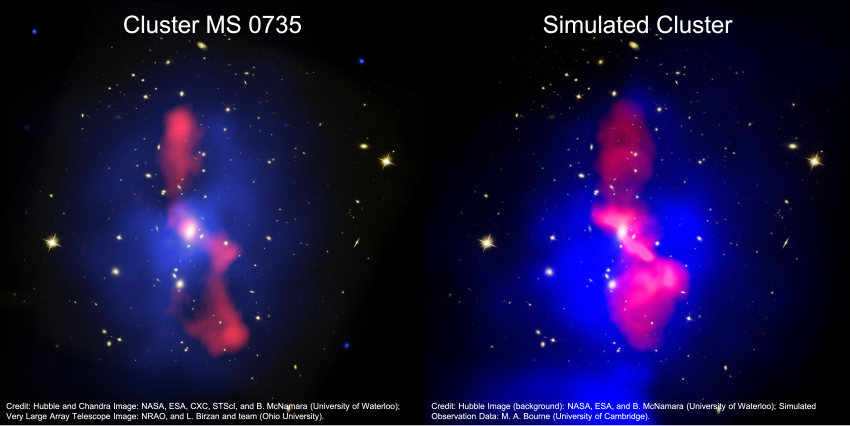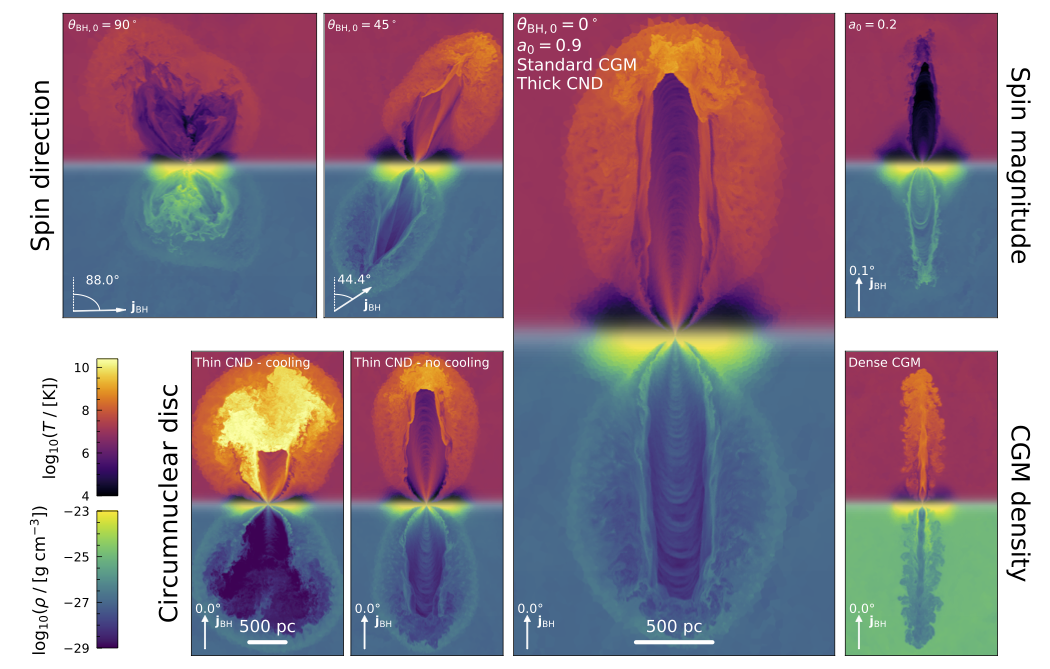Research highlight: Simulating AGN jets
Jets launched by active galactic nuclei (AGN) are believed to play a significant role in shaping the properties of massive galaxies and provide an energetically viable mechanism through which star formation can become quenched. Studying AGN feedback is made difficult, however, by the fact that it is an inherently multi-scale problem with significant coupling between processes on disparate scales. At KICC we, therefore, use numerical simulations and novel algorithms aimed to bridge vast spatial scales to study AGN feedback of which there are numerous open questions regarding its nature.
On galaxy cluster scales, it is well accepted that the vast amount of energy injected into the jet lobes is sufficient to offset the cooling losses within the intracluster medium (ICM) and prevent the formation of a cooling catastrophe. However, the processes by which this jet energy is effectively and largely isotopically communicated to the ICM is not well understood. Simulations carried out at KICC, with AGN jets of an unprecedented resolution injected in a self-consistent cosmological environment, showed that the ICM motions or “weather” in addition to weak shocks are crucial to solving this problem. Through the cluster weather action, the jet lobes can be significantly moved and deformed, stirring them around the cluster, which ultimately leads to jet lobe disruption and effective energy transfer to the ICM.
X-ray mock observations of our simulated clusters clearly show the so-called “X-ray cavities” and “X-ray bright rims” generated by supermassive black hole-driven jets. Remarkably, many of the features of these mock observations resemble those found in observations of real galaxy clusters as depicted in Figure 1.
.
Figure 1: The left hand panel shows an actual observation of the galaxy cluster MS 0735.6+7421, while on the right the background Hubble image has instead been overlaid with a mock observation of the jet (pink) and X-ray emission (blue) made from the simulation. Both images show cavities excavated by the lobe inflation surrounded by X-ray bright rims of dense gas (blue), which are filled by distorted jet material (pink). Credit Hubble and Chandra Image: NASA, ESA, CXC, STScI, and B. McNamara (University of Waterloo); Very Large Array Telescope Image: NRAO, and L. Birzan and team (Ohio University); Simulated Data: M. A. Bourne (University of Cambridge)
One of the most promising processes by which AGN jets are launched is that of the Blandford-Znajek mechanism. Here, magnetic fields extract spin-energy from a Kerr black hole which is then used to launch jets parallel to the spin axis of the black hole.
Motivated by this, at KICC we have developed a self-consistent sub-grid model for AGN accretion and feedback in the form of a Blandford-Znajek jet. Applying our model to simulations of the central regions of a typical Seyfert galaxy, we found that the outflow morphologies are highly dependent on the black hole spin magnitude and direction (see Figure 2) with the jets launched by misaligned black hole spins driving turbulent, multi-phase, quasi-bipolar outflows.
This jet model also provides a useful tool to investigate the impact of AGN feedback in galaxy mergers. We will be able to investigate the link between electromagnetic observations and gravitational wave signals that would result if the black holes coalesce. This area of research is particularly important with the advent of multi-messenger astronomy and observatories such as Athena and LISA on the horizon.




